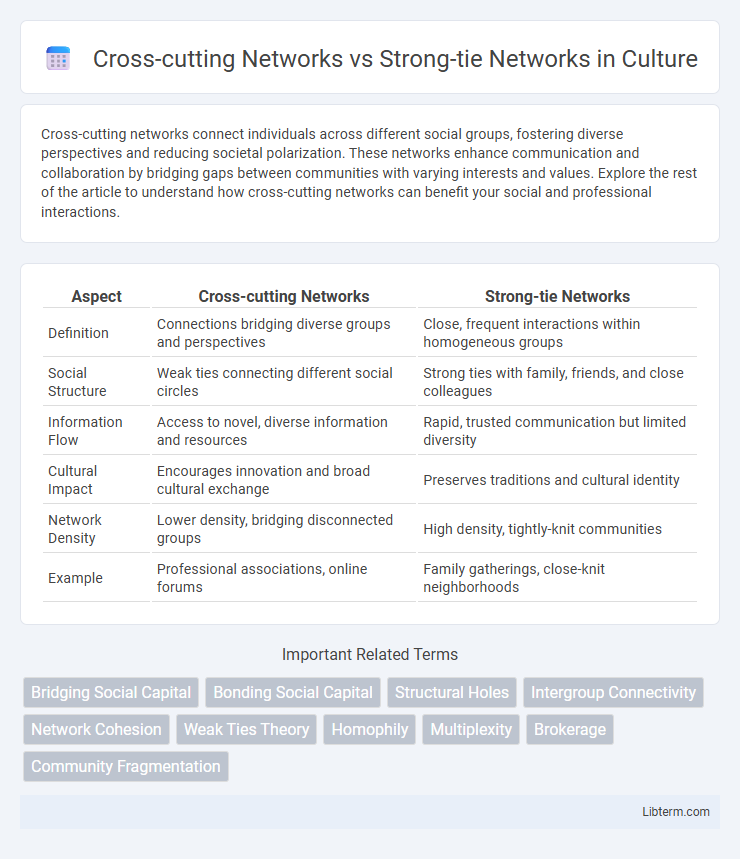Cross-cutting networks connect individuals across different social groups, fostering diverse perspectives and reducing societal polarization. These networks enhance communication and collaboration by bridging gaps between communities with varying interests and values. Explore the rest of the article to understand how cross-cutting networks can benefit your social and professional interactions.
Table of Comparison
| Aspect | Cross-cutting Networks | Strong-tie Networks |
|---|---|---|
| Definition | Connections bridging diverse groups and perspectives | Close, frequent interactions within homogeneous groups |
| Social Structure | Weak ties connecting different social circles | Strong ties with family, friends, and close colleagues |
| Information Flow | Access to novel, diverse information and resources | Rapid, trusted communication but limited diversity |
| Cultural Impact | Encourages innovation and broad cultural exchange | Preserves traditions and cultural identity |
| Network Density | Lower density, bridging disconnected groups | High density, tightly-knit communities |
| Example | Professional associations, online forums | Family gatherings, close-knit neighborhoods |
Introduction to Cross-cutting and Strong-tie Networks
Cross-cutting networks connect individuals across diverse social groups, fostering innovation and the exchange of varied perspectives by bridging structural holes. Strong-tie networks consist of close-knit, frequent interactions that build trust and facilitate efficient information flow within homogeneous groups. Understanding the interplay between these networks is crucial for leveraging social capital and optimizing collaboration in organizational and social contexts.
Defining Cross-cutting Networks
Cross-cutting networks consist of connections linking diverse social groups, facilitating access to heterogeneous information and resources that bridge socioeconomic, cultural, or professional divides. These networks enhance innovation and problem-solving by integrating multiple perspectives and fostering resilience through exposure to novel ideas. Unlike strong-tie networks characterized by dense, emotionally close relationships, cross-cutting ties are typically weaker but crucial for broadening influence and opportunities across disparate communities.
Characterizing Strong-tie Networks
Strong-tie networks consist of close-knit relationships characterized by frequent interactions, emotional intensity, and high trust levels, typically found among family members, close friends, and tight-knit work groups. These networks facilitate rapid information exchange and robust social support, enhancing cooperation and shared norms within the group. Despite their reliability, strong-tie networks often result in redundant information flows and limited access to novel resources or opportunities compared to cross-cutting networks.
Key Differences Between Cross-cutting and Strong-tie Networks
Cross-cutting networks connect individuals across diverse social groups, fostering access to varied information and resources, while strong-tie networks consist of close, frequent interactions within homogenous groups emphasizing trust and emotional support. Cross-cutting ties enhance innovation and problem-solving by bridging social divides, whereas strong ties strengthen cohesion and reliability within tight-knit communities. The key differences lie in the scope of connections--cross-cutting networks span heterogeneous groups, whereas strong-tie networks maintain relationships through repeated, intimate interactions.
Advantages of Cross-cutting Networks
Cross-cutting networks provide diverse perspectives and access to a wider range of resources compared to strong-tie networks, which are often more homogeneous. They enable greater innovation by bridging different social groups and fostering novel information flow. This diversity enhances problem-solving abilities and adaptability in dynamic environments.
Benefits of Strong-tie Networks
Strong-tie networks provide deep trust and emotional support, enhancing collaboration and information sharing among closely connected individuals. These networks facilitate rapid problem-solving and coordinated action due to strong mutual commitment and frequent interactions. Their reliability and stability make them essential for fostering resilience and effective teamwork in organizational and social settings.
Social Influence and Information Flow
Cross-cutting networks foster diverse social influence by bridging different social groups, promoting heterogeneity in information flow and reducing echo chamber effects. Strong-tie networks, characterized by close, frequent interactions, enhance trust and speed of information transmission within homogeneous groups but can limit exposure to novel ideas. Effective social influence occurs when cross-cutting ties introduce new perspectives, while strong ties reinforce shared norms and behaviors through repeated, reliable exchanges.
Innovation and Diversity in Network Structures
Cross-cutting networks, characterized by weak ties connecting diverse groups, significantly enhance innovation by facilitating access to novel information and varied perspectives. Strong-tie networks, composed of close-knit relationships, provide trust and cohesion but often limit exposure to heterogeneous ideas, reducing diversity. Balancing both network structures fosters a dynamic environment where innovation thrives through the integration of diverse knowledge and reliable collaboration.
Challenges Faced by Each Network Type
Cross-cutting networks face the challenge of managing diverse perspectives that can lead to conflicts and slow decision-making due to the lack of shared norms. Strong-tie networks struggle with redundancy and limited access to novel information because of dense interconnections and homogeneity. Both network types encounter difficulties in balancing cohesion and information flow, affecting their overall efficiency and adaptability.
Choosing the Right Network for Your Goals
Cross-cutting networks connect diverse groups with varying perspectives, fostering innovation and access to novel information, ideal for problem-solving and creative projects. Strong-tie networks comprise close, trust-based relationships providing emotional support and reliable collaboration, suitable for tasks requiring deep commitment and coordination. Selecting the right network depends on goals: leverage cross-cutting ties for expansive reach and fresh ideas, while strong-tie networks excel in reinforcing cohesion and shared understanding.
Cross-cutting Networks Infographic

 libterm.com
libterm.com